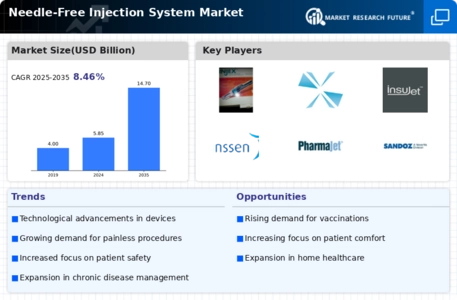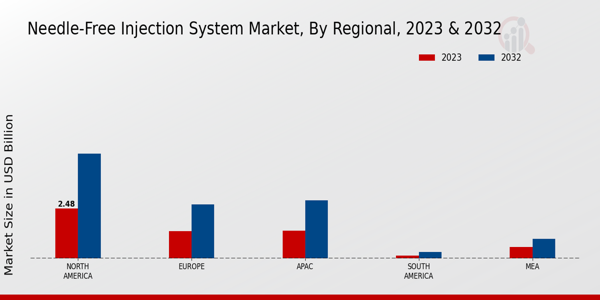Market Growth Projections
The Global Needle-Free Injection System Market Industry is on a promising growth trajectory, with projections indicating a market value of 5.85 USD Billion in 2024 and an anticipated increase to 14.7 USD Billion by 2035. This growth reflects a compound annual growth rate of 8.72% from 2025 to 2035, driven by various factors such as technological advancements, increasing prevalence of chronic diseases, and heightened patient comfort. The market's expansion is further supported by regulatory approvals and the growing adoption of needle-free systems in emerging markets. These projections underscore the potential for needle-free technologies to revolutionize drug delivery and improve patient outcomes globally.
Technological Advancements
The Global Needle-Free Injection System Market Industry is experiencing a surge in technological advancements that enhance the efficacy and safety of drug delivery. Innovations such as micro-needle technology and jet injectors are gaining traction, allowing for precise and painless administration of vaccines and medications. These advancements not only improve patient compliance but also reduce the risk of needle-stick injuries. As a result, the market is projected to reach 5.85 USD Billion in 2024, reflecting a growing preference for non-invasive delivery methods. The integration of smart technologies, such as digital monitoring systems, further supports the industry's expansion by providing real-time data on patient adherence.
Patient Comfort and Compliance
Patient comfort is a pivotal factor influencing the Global Needle-Free Injection System Market Industry. Traditional needle-based injections can cause anxiety and discomfort, leading to non-compliance among patients. Needle-free systems mitigate these concerns by providing a virtually painless alternative, which is particularly appealing to pediatric and needle-phobic populations. This increased comfort can enhance patient adherence to vaccination schedules and chronic disease management. As healthcare providers prioritize patient-centric approaches, the adoption of needle-free technologies is likely to rise, further driving market growth. The anticipated compound annual growth rate of 8.72% from 2025 to 2035 underscores the importance of patient comfort in shaping the future of drug delivery.
Regulatory Support and Approvals
Regulatory bodies worldwide are increasingly recognizing the benefits of needle-free injection systems, which is fostering growth within the Global Needle-Free Injection System Market Industry. Approvals for various needle-free devices are being expedited, reflecting a commitment to innovation in drug delivery. For instance, the U.S. Food and Drug Administration has been actively reviewing and approving needle-free technologies, which enhances market confidence. This regulatory support not only encourages manufacturers to invest in research and development but also assures healthcare providers of the safety and efficacy of these systems. As a result, the market is poised for substantial growth, driven by a favorable regulatory landscape.
Emerging Markets and Global Expansion
Emerging markets are playing a crucial role in the growth of the Global Needle-Free Injection System Market Industry. Countries in Asia-Pacific and Latin America are witnessing a rise in healthcare investments, leading to increased adoption of advanced medical technologies. The growing middle-class population in these regions is also driving demand for innovative healthcare solutions. As healthcare infrastructure improves, needle-free injection systems are becoming more accessible, facilitating their integration into routine medical practices. This trend is expected to contribute significantly to the market's expansion, with projections indicating a robust growth trajectory as these regions embrace modern healthcare technologies.
Increasing Prevalence of Chronic Diseases
The rising incidence of chronic diseases globally is a significant driver for the Global Needle-Free Injection System Market Industry. Conditions such as diabetes, cardiovascular diseases, and autoimmune disorders necessitate regular medication, often requiring injections. Needle-free systems offer a more comfortable alternative for patients, potentially increasing adherence to treatment regimens. As the global population ages and the prevalence of these diseases escalates, the demand for efficient drug delivery systems is expected to grow. This trend is likely to contribute to the market's expansion, with projections indicating a market value of 14.7 USD Billion by 2035, highlighting the critical role of needle-free technologies in modern healthcare.









